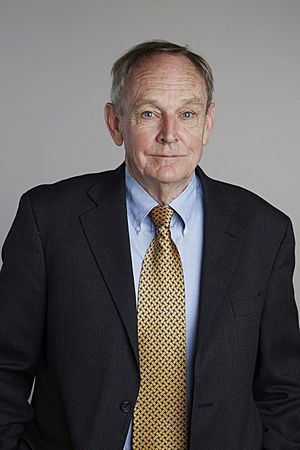William Hughes Miller facts for kids
Quick facts for kids
William Miller
|
|
|---|---|

William Miller in 2015, portrait via the Royal Society
|
|
| Born |
William Hughes Miller
March 16, 1941 |
| Education |
|
| Spouse(s) | Margaret Ann Westbrook |
| Awards |
|
| Scientific career | |
| Fields | Theoretical chemistry |
| Institutions | University of California, Berkeley |
William Hughes Miller, born on March 16, 1941, in Kosciusko, Mississippi, is an American professor. He is a top researcher in theoretical chemistry at the University of California, Berkeley.
Contents
William Miller's Work
Professor Miller is famous for creating special ways to understand how chemicals react. These methods are called semiclassical methods and they help scientists study chemical dynamics. This means they look at how atoms and molecules move and change during chemical reactions.
Leading the Chemistry Department
From 1989 to 1993, Professor Miller was the head of the chemistry department at the University of California, Berkeley. Since 1999, he has held a special title there: the Kenneth S. Pitzer Distinguished Professor.
Awards and Honors
Professor Miller has received many important awards for his work in chemistry. These awards show how much his research has helped the field.
Joining Important Academies
In 2011, he became a member of the German Academy of Sciences Leopoldina. This is a very old and respected science academy in Germany.
In 2015, he was chosen as a Foreign Member of the Royal Society (ForMemRS) in London. The Royal Society is one of the oldest and most famous scientific organizations in the world. Being a foreign member means he is recognized as a leading scientist from another country.
Why He Was Honored
The Royal Society explained that Professor Miller's work over 45 years has shaped the entire field of theoretical chemical dynamics. His key contributions include:
- A detailed theory for how atoms and molecules collide.
- A smart way to understand processes where electrons and atomic nuclei move together.
- A very accurate theory for tiny quantum events called "tunnelling."
- The most precise quantum theory for how fast chemical reactions happen.
These important ideas have helped scientists match their theories with what they see in experiments. His work is the foundation for almost all modern research in chemical reaction dynamics.
Other Major Awards
In 2007, Professor Miller received the Welch Award in Chemistry. He is also a member of the National Academy of Sciences and the International Academy of Quantum Molecular Science. These are all very high honors for scientists.
References

